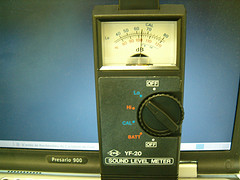
Analogue sound meter. Photo credit: jepoirrier on Flickr
Do smartphone apps have enough accuracy to collect and document noise exposure data?
This is a question received many times by NIOSH noise researchers, says this post in the NIOSH Science Blog. To find an answer, they downloaded 130 apps from the iTunes store and 62 apps from Google Play and assessed them against a range of criteria for accuracy.
Ten iOS apps and 4 Android apps met the preliminary criteria and were included in a pilot study. Of these, only one was found to be acceptable for occupational noise measurement. Although, according to the report, “interest in such sound measurement apps is growing among audio enthusiasts, educators, acoustic and environmental researchers, and the general public.”
Who’s tried the apps?
I talked with Jim Sandy, an audio engineer in Arizona. He is responsible for all audio equipment and sound testing at sporting events and concerts at the Jobing Arena. He told me how he uses his apps in tandem with his professional monitoring equipment.
“Because of the ease and accessibility of my smartphone, I’ve been relying more and more on the apps to do ‘spot’ measurements. If I need to verify something, I go grab my professional equipment,” Jim said.
“I now use my apps everywhere I go – restaurants, the subway, on an airplane, even the kids’ cafeteria the other day. I can imagine people making better and more informed decisions once they realize how loud a place is and in some instances demanding action to lower noise levels at sporting events.”
Help or hype?
I checked in with WorkSafeBC audiologist Sasha Brown, who says the apps should never be used in place of equipment that is verified to meet the applicable CSA and ANSI standards.
“From my perspective, these apps can raise awareness about noise, and can even help identify areas of a workplace that require further testing with a sound-level metre or dosimeter,” she said.
“While smartphone sound level measurement apps can help give workers, and others involved in their safety, a sense of the noise levels and potential noise exposure in a workplace, it’s worth keeping in mind that accuracy varies widely between apps.”
According to WorkSafeBC’s Hearing Loss Prevention web page, “noise-induced hearing loss is the most prevalent occupational disease and is permanent and irreversible. Approximately 300,000 B.C. workers are exposed to loud enough noise in their jobs to cause this disease.”


